Discover the project
The project presented provides for the creation of lanes dedicated to buses and specific developments to make bus traffic more fluid and thus increase their speed and regularity. It will be accompanied by a reorganisation of the local bus network and the creation of cycle lanes on a large part of the route.
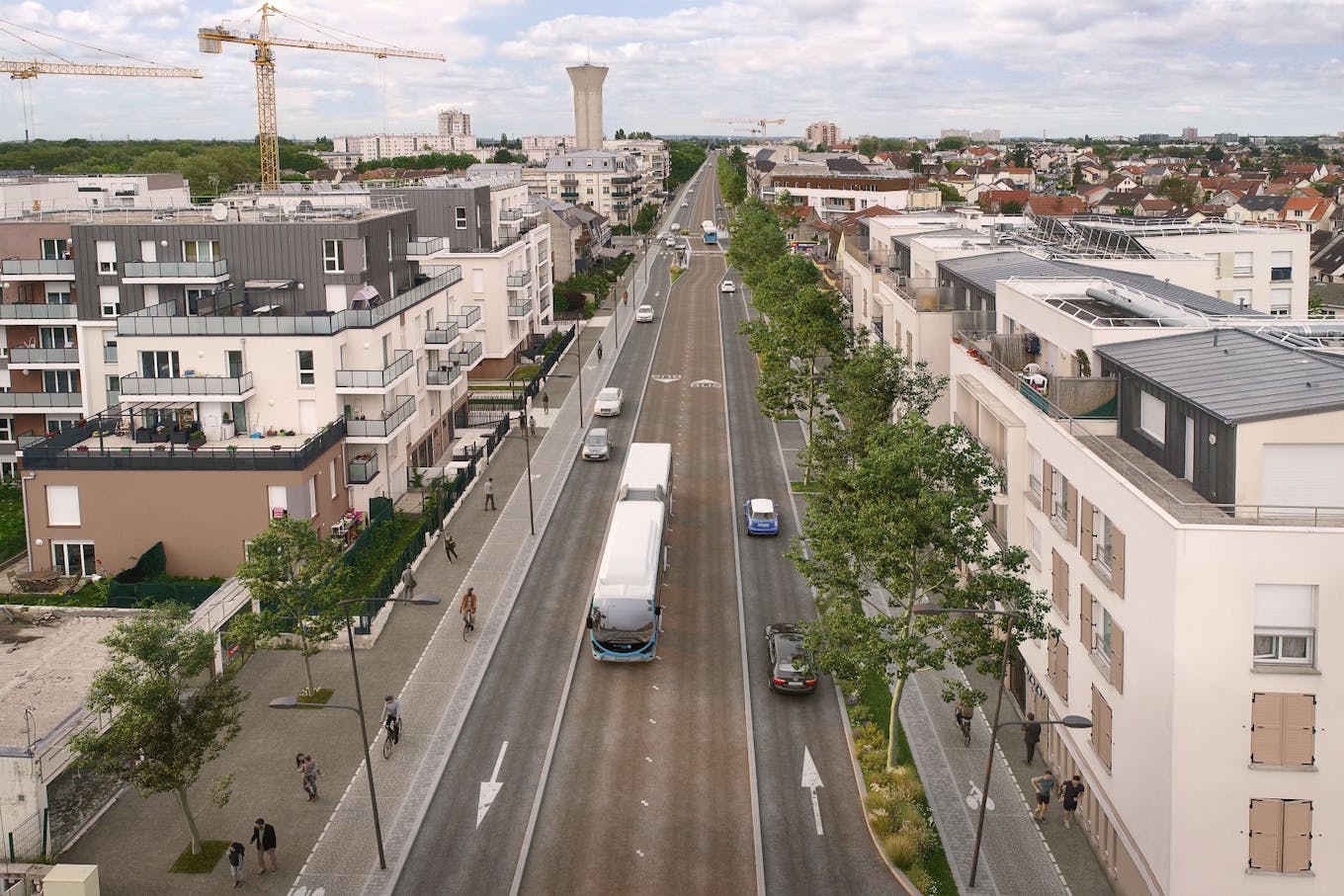
The project consists of creating dedicated bus lanes and specific developments to improve the flow of bus traffic (priority at intersections in sectors shared with private vehicles, for example) between Aulnay-sous-Bois and Tremblay-en-France. The route largely follows the route of the current line 15, between the RER stations of Aulnay-sous-Bois and Vert Galant, passing through the RER station of Sevran-Beaudottes, serving four municipalities (Aulnay-sous-Bois, Sevran, Villepinte, Tremblay-en-France).
The creation of dedicated bus lanes along the 9.2 km of the route and the implementation of specific facilities will improve user travel times (35 minutes between Aulnay-sous-Bois and Tremblay-en-France and an estimated gain of 8 to 10 minutes) and the performance of the entire bus network in the sector. Freed from the vagaries of traffic, the bus will also provide a more efficient service to the major transport hubs in the region (RER B, future line 16 of the Grand Paris Express in Sevran-Beaudottes).
The creation of lanes dedicated to buses will be accompanied by a requalification of public spaces: creation of cycle routes, pedestrian paths, landscaping, etc.
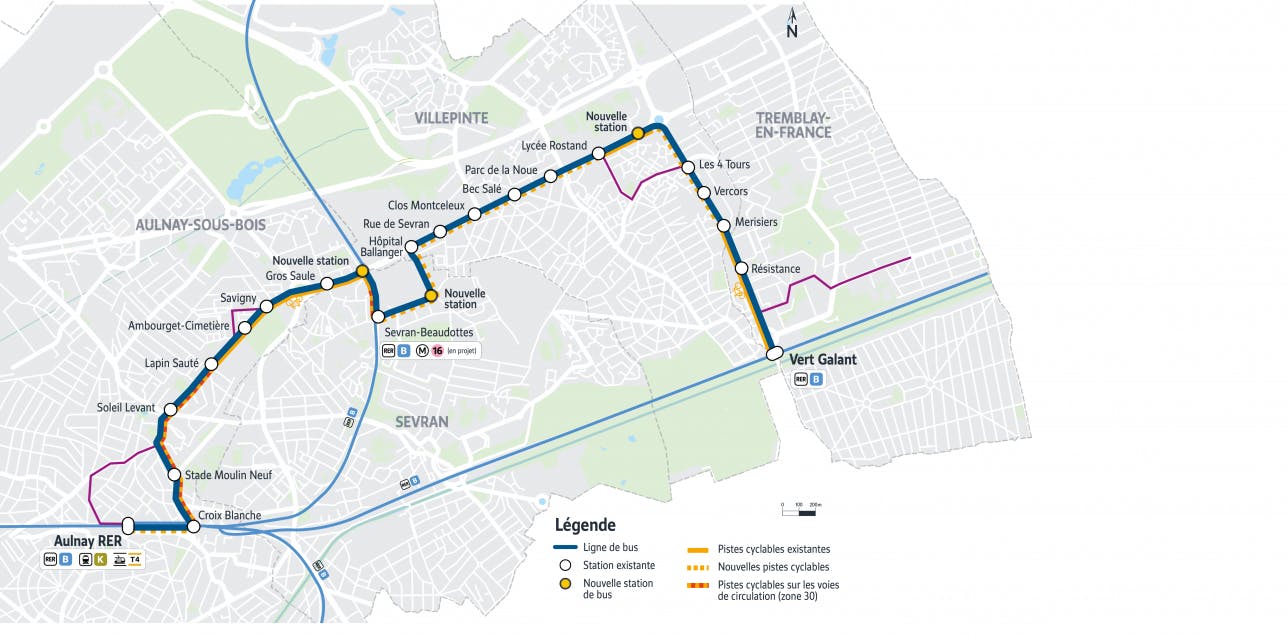
Plan
The objectives of the project
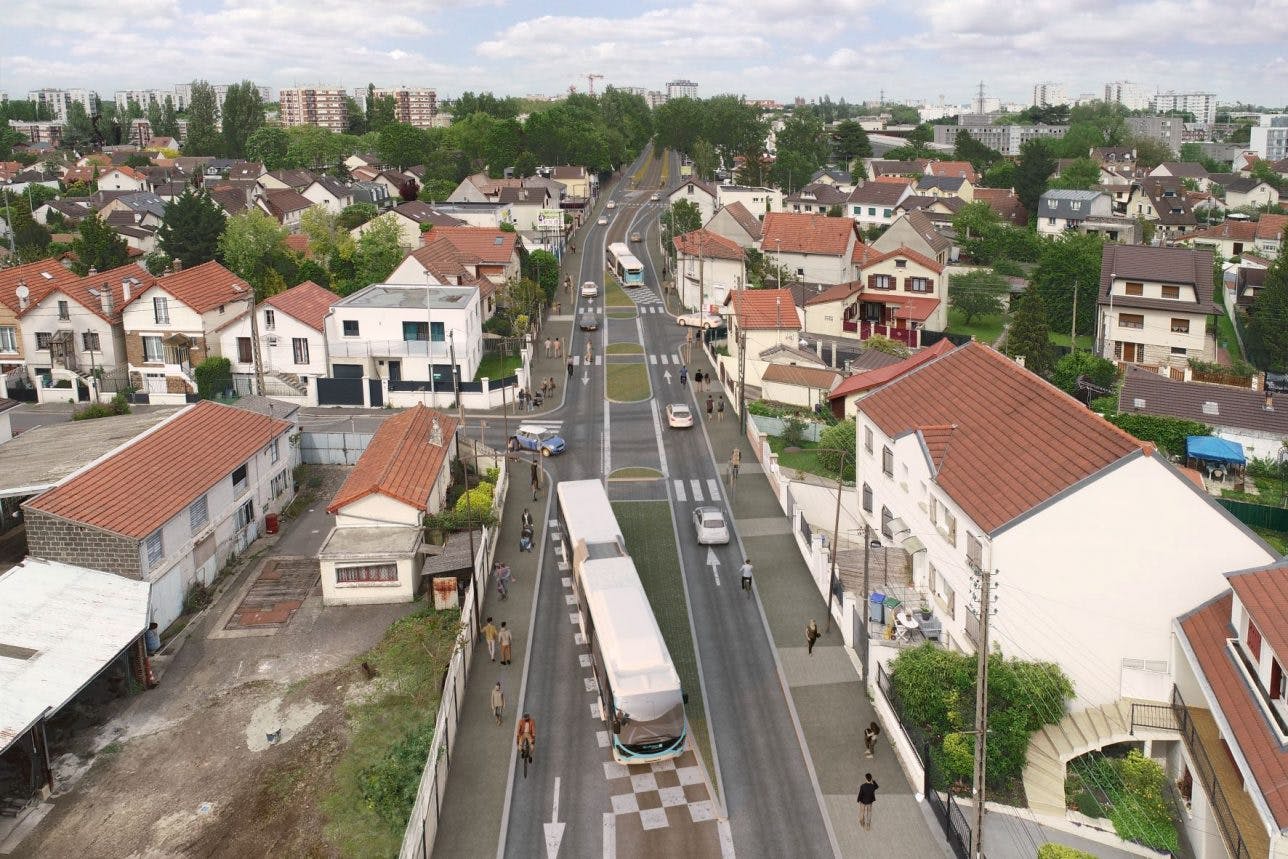
- To offer a fast, reliable and comfortable means of transport and to improve the performance of other bus lines in the territory;
- Ensure efficient links and connections to station hubs (Aulnay-sous-Bois; Sevran-Beaudottes and Vert-Galant);
- Support the development projects of the territory by serving as closely as possible the areas in project (in particular the ZAC de la Pépinière and Parc de la Noue);
- Create continuous, comfortable and safe routes for alternative travel such as walking and cycling;
- To improve the living environment by contributing to the renovation of public spaces and the calming of traffic.
The route and the developments
The project is part of a very dense urban environment, with sometimes constrained lane widths. As a result, the project provides for several types of insertion of dedicated bus lanes, depending on the environment they will cross and to limit land acquisitions:
Dedicated bus lanes in both directions
The insertion of dedicated bus lanes in each direction may imply, in some cases, the reduction of traffic lanes, but will allow the creation of cycle lanes or the widening of pedestrian sidewalks. This development option will be chosen in the widest areas, in order to promote a peaceful use of space for all modes of transport (pedestrians, cyclists, cars and collectives).
The lanes dedicated to buses can be positioned in an axial position (the bus lane is in the center with the car lanes on each side) or lateral (the bus lane is on the side).
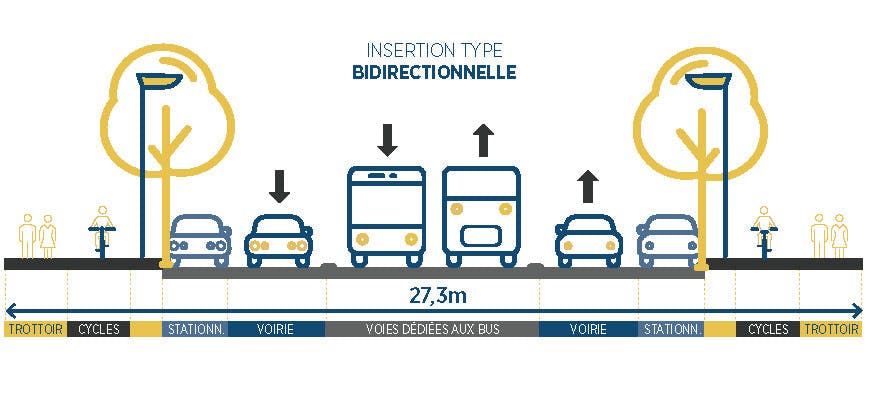
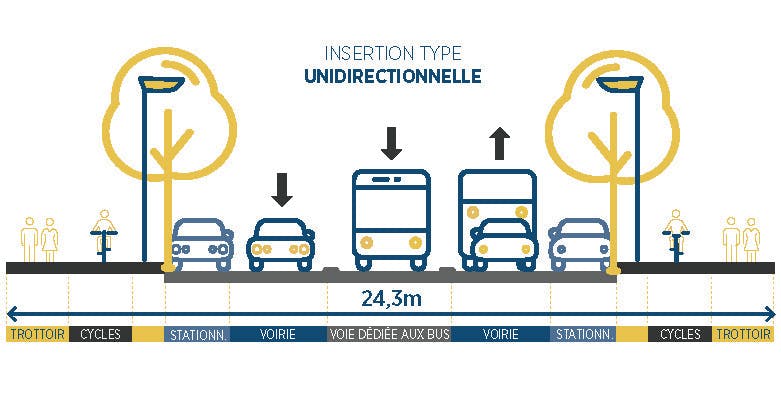
A dedicated lane for buses in one direction
In the most constrained areas, only a dedicated lane will be created so as not to impact the urban environment too heavily. Buses will run in dedicated lanes in one direction, and will run in car lanes in the other direction.
Numerous connections
The TCSP will establish numerous connections with the other major modes of transport in the territory, in service and in the pipeline: in connection at the RER station in Aulnay: RER B, Transilien K, Tram T4; in connection at Sevran-Beaudottes station: RER B, Future metro line 16 of the Grand Paris Express in project; at the Vert-Galant station: RER B.
Connections with buses and the deployment of new cycle routes are also taken into account as part of the project.
A more accessible, fast and comfortable bus
With a bus every five to six minutes during rush hour and an estimated travel time of 35 minutes from Aulnay-sous-Bois to Vert Galant (i.e. a time saving of 8 to 10 minutes), the territory will soon have a fast and efficient means of transport that will best serve the districts and allow easier interconnections with other modes of transport.
Stations and pedestrian facilities will comply with current accessibility standards to allow people with reduced mobility to move around safely.
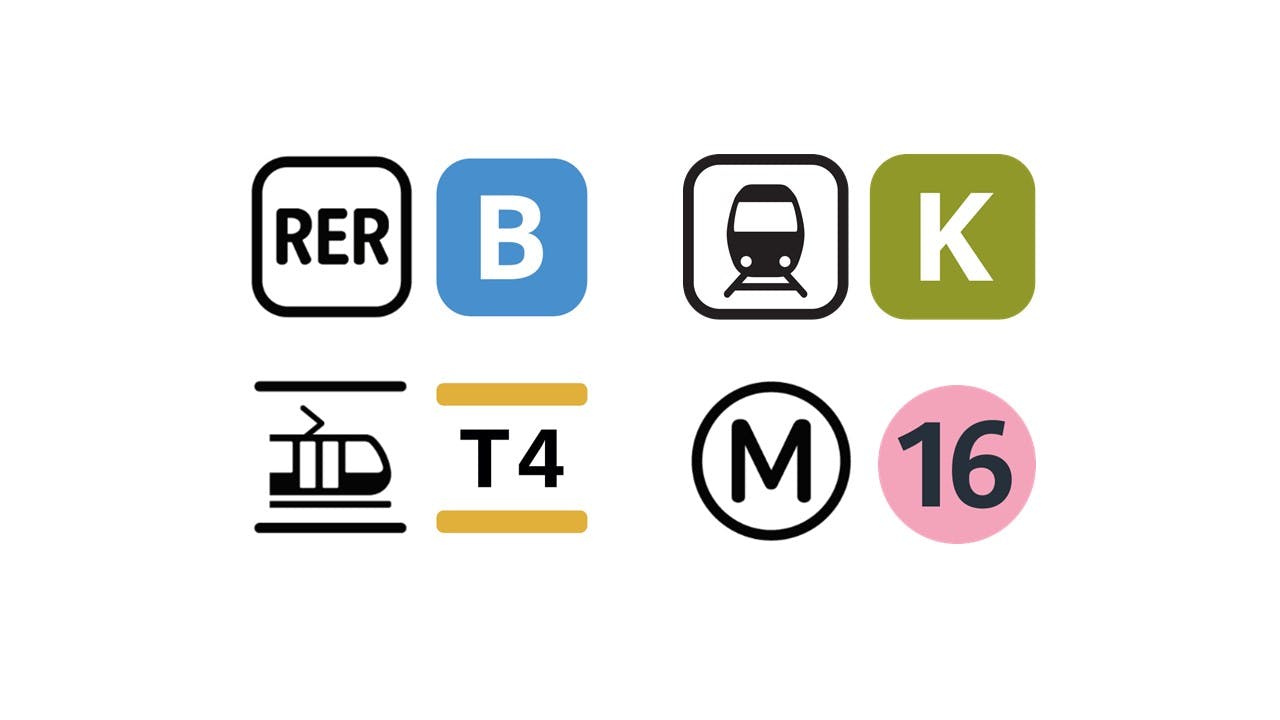
The project and the bike
Today, the territory suffers from a lack of continuous cycle routes that limits the use of bicycles. The TCSP project plans toconnect the existing cycle sections in order to create continuous cycle routes along the entire route.
With the exception of a 1.5 km zone where bicycles will circulate in the traffic lanes (in a zone limited to 30 km/h), the cycle routes will consist of cycle lanes along the entire route. In total, more than 7.5 km of dedicated roads will be able for cyclists to use in complete safety.
Facilities for bicycle parking are planned at each interchange hub.
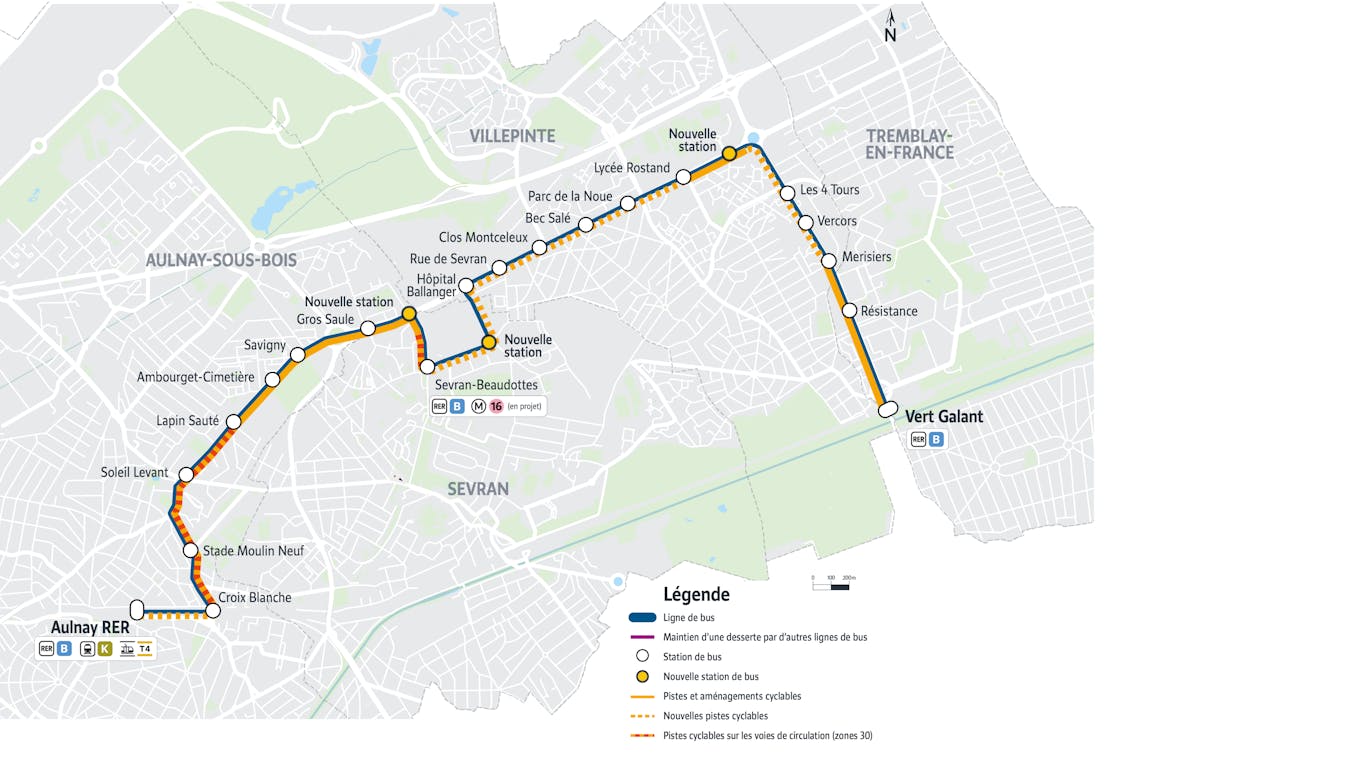
The calendar
- 2020-2021: Pre-studies
- From September 20 to October 22: Prior consultation
- 2022*: Assessment of the consultation
- 2022-2023*: Schematic diagram
- 2023*: Public inquiry
- Coming*: Design studies and works
* The dates indicated will be reassessed as the project progresses. The phasing of the work and commissioning will be specified after obtaining the Declaration of Public Utility following the public inquiry, during the design studies.
Financing and the actors
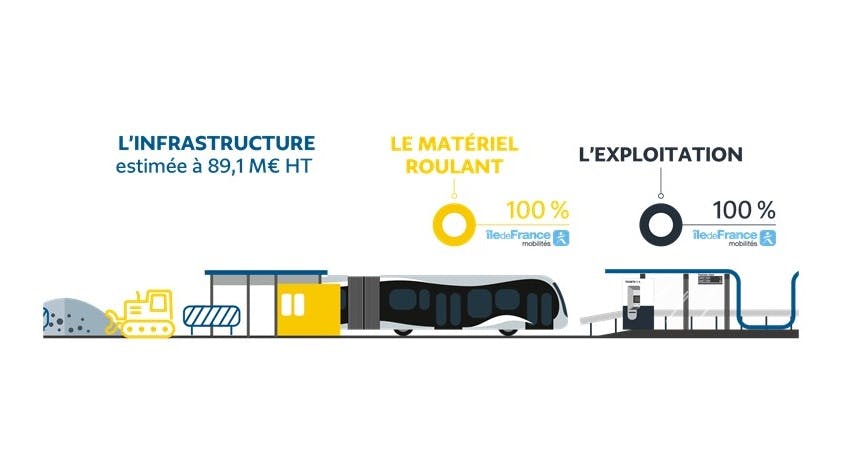
The State
Through the State-Region Plan Contract 2015-2020 (CPER), the State is contributing to the modernisation and development of transport lines in the Île-de-France region to meet the travel challenges and expectations of Ile-de-France residents. By financing this project, the State is committed to offering Ile-de-France residents more efficient transport to move towards a sustainable city and a more peaceful lifestyle. The State is pursuing its objective of making the transport network more efficient by making it part of the dynamics of the territories in order to better meet the daily needs of users, to improve access to transport for all and thus strengthen the attractiveness of the Île-de-France region. The State is financing the preliminary studies (DOCP) of this project, up to the public interest inquiry, up to 21%, in accordance with the State-Region Plan Contract.
The Île-de-France Region
To meet the demand of all users, the Region is investing massively to modernise and expand the public transport network. Together with Île-de-France Mobilités, the Region has been engaged in the transport revolution since 2016 to profoundly improve the transport conditions of Ile-de-France residents. The creation of new tram lines is part of this major programme. The Region devotes very significant financial resources to it. The Region is the main funder of the preliminary studies (DOCP) of this project, up to the public interest survey, up to 49%.
The EPT Paris Terres d'Envol
As the international gateway to the Ile-de-France metropolis, Paris Terres d'Envol has an active policy to develop the transport offer and sustainable mobility for the inhabitants of its eight cities. Faced with the many challenges of the territory, Paris Terres d'Envol participates in the operation of bus networks and organizes intermodality around stations. The TCSP project between Aulnay-sous-Bois and Tremblay-en-France is fully in line with the mobility strategy implemented in close collaboration with its member cities and will effectively support the arrival of the future Grand Paris Express stations. This project is 20% financed by the territory.
The Department of Seine Saint-Denis
Because it is a major social, economic and environmental issue, the Department of Seine-Saint-Denis is mobilised for the development of active modes of transport and is committed to improving the quality and quantity of public transport in the region. It actively participates in the deployment of the bus network and the extension of metro lines, and supports the construction of the new Grand Paris Express metro lines. The Department finances the studies of this TCSP project to the tune of 10%.
Île-de-France Mobilités
At the heart of the Île-de-France transport network, Île-de-France Mobilités imagines, organises and finances innovative solutions for all forms of mobility today and tomorrow. It decides on and manages projects for the development and modernisation of all transport (train, metro, tram, bus and cable) which it entrusts to transport companies. It also develops solutions for mobility such as Navigo, Vianavigo or Véligo. Île-de-France Mobilités brings together all the players (passengers, elected officials, manufacturers, carriers, infrastructure managers, etc.) and invests to improve the service provided every day to the people of the Ile-de-France region (more efficient, more modern, safer, more comfortable transport, etc.). and more connected). Île-de-France Mobilités finances 100% of the rolling stock and operation of the TCSP.